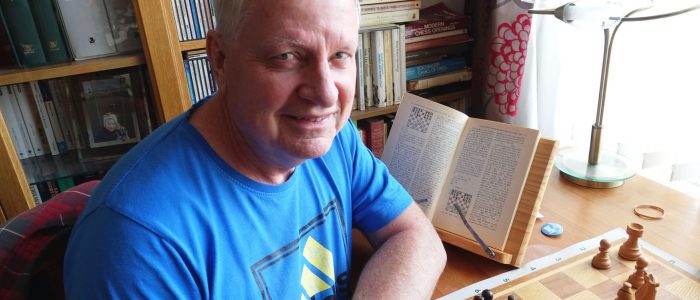Organ Donation Week 2019
It’s Organ Donation Week (02 – 08 September) and the law around organ and tissue donation in Scotland is changing. From Autumn 2020, if people have not confirmed whether they want to be an organ donor, it may be assumed they’re willing to donate when they die. People have a choice, and can record their decision on the NHS Organ Donor Register at any time. Sharing that decision with family and friends is vital, so they can ensure it is honoured should something happen.
Transplant recipient Dr David Fowler from Bonnybridge shares his story in a bid to raise awareness of how organ and tissue donation saves and transforms lives.
Dr Fowler says he cannot emphasise enough the importance of getting regular eye checks. Fifteen years ago he popped into a High Street chain of opticians for an appointment to be told the optometrist wasn’t happy and something didn’t look right. At that stage David had no symptoms. Referral to an eye specialist resulted in a diagnosis of Fuchs Corneal Endothelial Dystrophy an eye disease in which the innermost layer cells of the cornea undergoes progressive degenerative change. This cell layer, called the endothelium, is responsible for maintaining the proper amount of fluid in the cornea by pumping out excess.
The advice was clearly described. Your eye condition is progressive and if it deteriorates and you don’t have something done about this, there is a risk you may lose vision.
For David, this was a tremendous blow. With reading the love of his life he feared he would no longer be able to enjoy books. He also faced not being able to drive, and to enjoy hobbies such as chess.
Over the years David was monitored constantly. He recalled: “My vision was getting poor, everything was fuzzy. It was getting to the stage where I couldn’t drive at night, particularly in winter when there was glare due to rain. Even in daylight a low sun on the horizon made driving difficult. I was also getting to the point where I was having problems with print fonts, particularly italic. Reading is one of my biggest delights in life and I was at the stage where I couldn’t read the introduction to a novel if it was printed in italic. The sort of literature I read is not like dime novels, where there’s space between the lines. Those I read are sometimes very small print and it’s lucky to get any spacing at all. The computer became a problem too, especially glare from the screen.”
David, now retired from a mental health charity, had his first corneal graft two years ago at the Queen Margaret Hospital in Dunfermline. David describes it as “the Rolls Royce of treatments” and “a dramatic leap forward in eye technology.”
The cornea has three layers (thin outer and inner layers and a thick middle layer). In some diseases only the inside layer (endothelium) is affected causing corneal swelling and clouding in the middle layer.
The operation is usually performed under local anaesthetic and takes about one hour. For technical reasons, a cataract and implant lens operation is required to have been done in advance. Through a small incision the endothelium is removed and a disc of donor endothelium is inserted and pressed in position against the back of the corner by a bubble of air. Patients usually need to life flat for one or two days after the operation. Any stitches in the cornea are easily removed in a clinic in the weeks after the procedure.
On June 4th 2019, David’s left eye was operated upon at Forth Valley Royal Hospital. Both procedures have been successful and David says everyone is happy with his progress. His corneal graft has been life-changing.
He explained: “I used to wear spectacles all the time, bi-focals. The only time I wear glasses now is for reading and my eyes don’t water the way they used to. As far as my vision is concerned colours are much more vivid. Before it was like dissolving a paracetamol in a glass of water, cloudy. Now everything is sharp and the definition is brilliant.
“I’m very grateful to the tissue donors and their families. Sadly I can’t express my thanks to the people kind enough to allow eye retrieval. I think it’s very important for someone to sign up to become an organ or tissue donor and that medical staff have the courage to approach families at a time of grief and mourning.
“Thanks to those persons no longer with us, it means I can drive and I can read until I die. I will be on my deathbed clutching a novel! I now have ten grandchildren, including the recent addition of twins born at Forth Valley Royal Hospital, and I will be able to see them grow up.”
Over the past year cornea donation in NHS Forth Valley has doubled, thanks to an innovative scheme devised by a doctor working in the Emergency Department at Forth Valley Royal Hospital. Susan Macmillan designed a prompt card which acts as an aide memoire to the process of approaching a family and the criteria for tissue donation. The size of a credit card, it tucks into the back of staff identification badges and was part of a Quality Improvement Project to increase the rate of tissue donation from the Emergency Department.
Apart from corneas, tissues that can be donated after death include heart valves, skin and tendons. The gift of sight is life changing for recipients and donated heart valves, which are often transplanted into children, can be lifesaving. Skin is used to dress the wounds of patients who have been severely burned and donated tendons can be used to restore function and improve the quality of life for patients.
More information about the opt out system of organ and tissue donation, and your choices can be found at www.organdonationscotland.org





